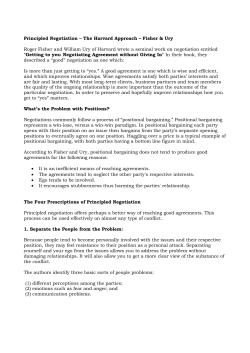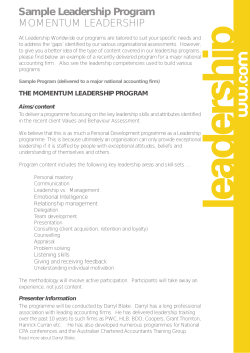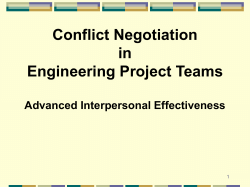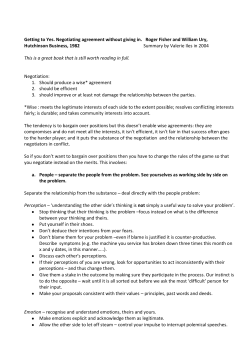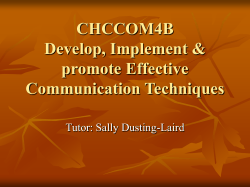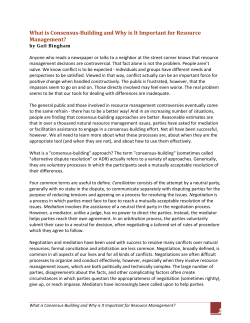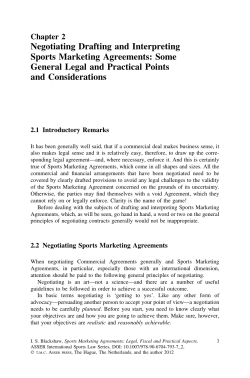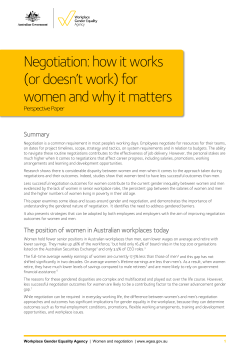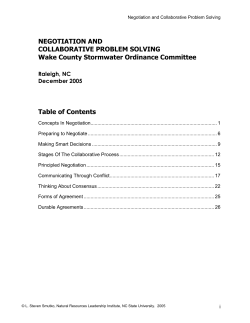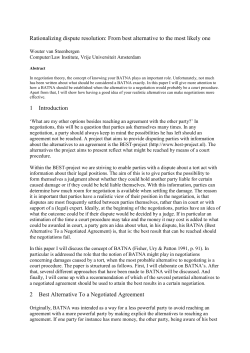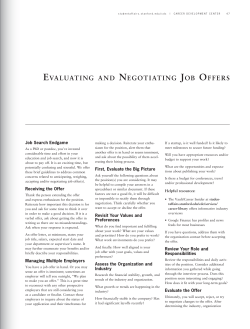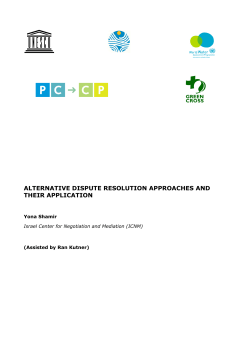
BOOK SUMMARIES and Background information on negotiation
BOOK SUMMARIES and Background information on negotiation GETTING TO YES, NEGOTIATING AGREEMENT WITHOUT GIVING IN Roger Fisher, William Ury & Bruce Patton1 Book summary by Manon Schonewille2 In recent decades a great deal of research has been carried out into the effects of different negotiating techniques. Negotiations can be subdivided into two broad categories: (1) distributive or positional bargaining (based on positions) and (2) integrative (problem solving) or principled negotiation (on the basis of interests). Distributive negotiating can be efficient in simple situations, for example when bargaining at a market stall. More complex negotiations often require integrative/principled strategies or a mix of styles. For much of the last century, negotiations were based on ‘competitive’ or ‘positional’ bargaining principles. However, in the nineteen sixties and seventies, a number of publications emerged, reflecting new and important thinking about the negotiation process, especially in the field of industrial relations.3 In 1981, Fisher and Ury (and in later editions, Patton) published their ground breaking book ‘GETTING TO YES,’ marking a whole new approach towards negotiation and dispute resolution: principled negotiation, also known as problem-solving, interest-based, integrative, mutual gain, win-win or the Harvard approach to negotiation (referring to its intellectual roots in the Harvard Negotiation Project). The book was regarded as ground breaking because it clearly described and demystified the negotiation practice. Instead of emphasizing tactics on how to persuade the other side, this method focuses on principles and objectivity to obtain a fair result for all involved in a negotiation. Insights like separating the ‘people from the problem’, focusing on both parties’ interests rather than positions, inventing options for mutual gain, insisting on objective criteria, and employing new concepts like BATNA and WATNA4 were the key to a more constructive approach to negotiation. Later this was also called Best No Deal Options. Hereunder follows a summary of the key ideas of the methodology for principled negotiating that evolved from the Project On Negotiation (PON) of Harvard University in Cambridge, Mass, USA. And as described in the meanwhile ‘classic’ book GETTING TO YES, negotiating agreement without giving in by Fisher, Ury & Patton (1981). Getting to yes Trust, the relational aspect, and the business dimension of a negotiation together form the basis for creatively expanding the pie. They comprise the first step to an agreement based on the interests of all parties involved. Trust means having sufficient mutual confidence in the process and in each other as ‘partners in conflict’, or negotiators, to reach a satisfactory outcome. Dealing with personal aspects or relationship issues implies treating each other with respect. The interests (joint or diverging, but not necessarily irreconcilable) form the business dimension. The content aspects must be separated from the relationship issues. Conflicting interests are resolved on the basis of a shared sense of fairness, reciprocity, and objective criteria. At the same time parties are made aware of the alternatives open to them, and the need to reach a positive outcome with or without the other party. This is an especially important aspect in longterm relationships. Parties often fail to recognize this themselves. Interventions by the mediator or deal facilitator5 can help them realize this. If you are a negotiator yourself, it is important to understand this. 1 Roger Fisher, William Ury and Bruce Patton (1991). GETTING TO YES: NEGOTIATING AGREEMENT WITHOUT GIVING IN. Harvard Negotiation Project, 2nd edition. New York: Penguin Books 2 This is a rework of Manon Schonewille, (2009), TOOLKIT GENERATING OUTCOMES, Mediation, Negotiation, Chapter II.4 ‘Interest based negotiation’. The Hague: Sdu. Key contributors to the international edition: Prof. Laurence Boulle and Prof. Jacqueline Nolan-Haley. © Manon Schonewille. Reprinted with permission. 3 A groundbreaking book on negotiation in industrial relations A BEHAVIORAL THEORY OF LABOR NEGOTIATIONS was written by Walton & McKersie (1965), whose basic ideas have been applied to many fields outside of industrial relations. Their book was edited by Kochan & Lipsky (2003) into a book that takes in account recent developments in thinking about negotiation: NEGOTIATIONS AND CHANGE From the workplace to society. 4 BATNA, is the acronym for Best Alternative to Negotiated Agreement. This is the most positive scenario that can be envisaged if the negotiators fail to reach an agreement. Exploration of the BATNA ensures that the negotiated outcome is better than the available alternatives. WATNA refers to “Worst Alternative To a Negotiated Agreement” and instructs negotiators to also consider the worst consequences of not reaching agreement. Source: Glossary in Schonewille (2009). 5 5 Deal Facilitation is an assisted negotiation process in which a third-party professional, whom the parties see as neutral and independent, is engaged jointly by all parties to a prospective deal to support them in their communication and negotiation process as they seek to reach the 1 The rules of thumb from ‘getting to yes’ – 4 principles for effective negotiation Fisher, Ury and Patton describe four principles for effective negotiation as well as common obstacles to negotiation and ways to overcome them. 1 ‘Separate the people from the problem’ and ‘be hard on the problem, be soft on the people’. Building a good working relationship is of great importance to be able to negotiate substantive issues. • Make sure the parties to a negotiation ‘play the ball’, not the person. This prevents the negotiation turning into an ego and power struggle and it helps focus the discussion on the real issues. • Work on empathy: try to make your position or the emotions understandable to the other party. Understanding does not necessarily imply agreement. Faith issues aside, people generally cannot accept what they do not understand. • Be firm on the content and in clarifying the parties’ interests. Simultaneously prevent unnecessary harm to the relationship. 2 Focus on and negotiate from interests, not positions The interests of all parties are what matters. • Analyse all parties’ interests and avoid getting stuck in entrenched positions which were dug at the start of the negotiation or mediation. • Interests can be established by exploring the why? and why not? of a position. You can do this by asking different questions that together generate an answer to the why (not)?. Be careful not to ask why? too directly. It can be interpreted as confrontational and put people on the defensive. Another, less provocative way of asking ‘why?’ is ‘Can you help me understand the reason for …?’. • The most important interests are basic human needs like safety, (financial) security, a sense of belonging, recognition and being in control. ‘Needs’ have to be distinguished from ‘wants’. • Focus on the future and don’t get stuck in the past. The questions ‘to what purpose?’ and ‘how?‘ deal with the future and the question ‘why?’ deals with the past. 3 Generate a variety of options and look for mutual gain solutions Try to expand the pie. Do not assume a ‘fixed pie’ and do not look for the single solution. • Make sure the solution meets the interests of all parties. • Strive for a negotiating outcome that benefits all parties. Do not assume there must be a winner and a loser. 4 Employ objective criteria to be able to assess a solution Try to invent as many as possible criteria to help you select the best solution. • By developing objective criteria you can expedite the negotiation. You prevent power plays about subjective standards. Moreover, subsequent negotiations with constituents are facilitated. Getting to yes is clear, easy to read and suitable for both newbies and seasoned negotiators. With over two million copies sold worldwide no other book on negotiation is as influential and widely read as this one. Even 20 years after its first publication the book offers a highly recommended foundation that everybody who aspires to improve their abilities as a negotiator should peruse. best possible outcome. (Source: Moving Beyond “just” a deal, a bad deal or no deal. Pre-publication of Schonewille/Fox in ADR IN BUSINESS, PRACTICE AND ISSUES ACROSS COUNTRIES AND CULTURES, VOLUME II under the editorship of A. Ingen-Housz, Kluwer 2011. 2 GETTING PAST NO, NEGOTIATING YOUR WAY FROM CONFRONTATION TO COOPERATION William Ury6 Book summary by Manon Schonewille7 The key principles of Getting Past No The sequel to Getting to Yes is the classic Getting Past No, Negotiating your Way from Confrontation to Cooperation by William Ury. It describes methods to bring a reluctant party to integrative negotiating. The book offers five principles of what Ury calls ‘breakthrough negotiation’: break through obstacles and obtain win-win agreements with people who are at first resistant to principled negotiation approaches. The book is an answer to some challenging questions and barriers to principled negotiation and it describes how a negotiator can deal with counter parts who are not cooperative or even use dirty tricks and distributive situations where win-win solutions do not seem possible. 5 Steps to breakthrough negotiation According to Ury, five important steps for breakthrough negotiation have to be observed. 1. ‘Go to the balcony’ and think first when the other party responds unpleasantly or provokes you. Do not react impulsively because automatic responses tend to be negative and might further escalate the how things stand. Consider how you can react effectively. Stay in control. Postpone your reaction and take time to reflect and calm down. For example, take a mental break by saying nothing for a moment, repeating step-by-step what has been said so far, or take a time out. If you sense that the other party is trying to play a game, you could mention this (naming the game). In any case do not respond to opposition in the conventional way and resist the natural impulse to capitulate, walk away or strike back. Be the one in control. 2. Acknowledge the other parties’ position and refrain from attacking the other with counterarguments. You can only start negotiations when you have established a workable relationship. This can be done by applying techniques like active listening, paraphrasing and reflections, using ‘I messages’’8 or apologizing, admitting to a mistake, and looking for mutual understanding and agreement. However: Ury cautions to stand up for your principles as well. 3. Reframe9 a proposal rather than reject it outright. Stay away from ‘yes-no’ discussions. Do not be colour blind – life is not black and white. Configure the negotiation as a joint process, in which all parties have an interest in reaching an outcome that is acceptable to all involved. If a proposal under discussion is unacceptable, do not reject it right away. Try to reframe it into a proposal that may be negotiable. If the other party refuses to engage, then 6 William Ury (1993), GETTING PAST NO: NEGOTIATING YOUR WAY FROM CONFRONTATION TO COOPERATION, Program on Negotiation at Harvard Law School, New York: Bantam Books. 7 This is a rework of Manon Schonewille, (2009), TOOLKIT GENERATING OUTCOMES, MEDIATION, NEGOTIATION, Chapter II.4 ‘Interest based negotiation’. The Hague: Sdu. Key contributors to the international edition: Prof . Laurence Boulle and Prof. Jacqueline Nolan-Haley. © Manon Schonewille. Reprinted with permission. 8 An ‘I message’ is a statement about yourself or your feelings instead of a ‘You message’ that is a qualifying statement about the other party. Stating issues in terms of ‘I felt, feel, see,’ etc. generally make them easier acceptable to the other party than ‘You did, are, should,’ etc. Using ‘I messages’ is a technique to avoid accusing the other side and/or escalating a situation. 9 Reframing Also called re-contextualizing. Through reframing you can place what the other party says in a different frame of mind or a new context. Neutral or positive reframing makes it easier to transform a difficult issue into a topic that both parties are willing to discuss. Reframing is more powerful if done in: an option, an interest, an objective criterion, or a feeling. Source: Glossary in Schonewille (2009). 3 try to change the game that is being played or change the rules of the game. Important tools to achieve this are asking questions, using silences, and most important of all, reframing. 4. Build them a golden bridge instead of pushing or pulling the other party to one side or the other, try to let them get closer to you by themselves. Make it easy for the other party to say yes to your proposal. This can be done by mutualizing,10 jointly generating options and ideas, forward-looking reality testing, exploring the other party’s ideas in more detail and agreeing on package deals. Take also into account the interests of the respective constituencies and support the other side in preventing a possible loss of face. 5. Do not let the negotiation escalate, but do try to clarify potential consequences. Make it difficult for the other side to say no. Inform or ask about the consequences or how they will react if you don’t work things out, ask reality-testing questions, apply a risk analysis and demonstrate your BATNA, WATNA and RATNA11 (Best/Worst/Realistic Alternative To Negotiated Agreement). And if all else fails, apply your own BATNA and terminate the negotiation. But as Ury advises: at the same time let everyone involved know that ‘the golden bridge’ is still open. 10 11 Mutualizing: Emphasize common facts and mutual interests. RATNA is the acronym for Realistic Alternative to Negotiated Agreement. This is the most realistic, probable scenario that can be expected if the negotiators do not reach agreement. Source: Schonewille( 2009). 4 INTERESTS Chapter II-7 & 8 from Toolkit Generating Outcomes By Manon Schonewille12 Interests interests can be seen as the subjective criteria that form the basis of an outcome of a negotiation or a solution to a mediated settlement, so they need to be identified and brought to the surface in a mediation or negotiation. Classifying interests as common/joint or as differing interests is customary in mediation theory. 1. Common or joint interests In a mediation or negotiation it is good practice to identify the common interests and to bring these out into the open. Being aware of the common interests gives parties a sense of progress and shows that in addition to a dispute or different objectives there is also common ground. Maintaining relationships, staying in control, resolving the disputes oneself and striving for a quick solution are all examples of common interests. 2. Differing interests 2.1 Reconcilable differing interests Reconcilable differing interests usually concern matters which are important to one party and which can be satisfied by the other at relatively little cost or effort. Examples are: wanting to be taken seriously, demanding an apology or a clear explanation of the background of a regulation or a decision, achieving sales or profits. Also, restoring confidence is generally a reconcilable interest. It is often even a common interest. Reconcilable differing interests can usually be resolved promptly after the interest is brought to the surface; it ‘costs’ one party only a little while it moves the process a huge step forward. 2.2. Irreconcilable differing interests The term ‘irreconcilable differing interests’ speaks for itself. These interests are not easy to harmonize. Here, the needs of one party can often be satisfied only if the other party relinquishes an irreconcilable corresponding need. At least that is what it looks like superficially. In many cases, creative solutions can be generated that result in everybody (partly) getting what he needs, or sometimes even what he wants, but does not necessarily need. Examples of irreconcilable differing interests can be neighbors not accepting noise or smells from a farm versus the farm needing to go about its business without interference (a). Or wanting to retain the exclusive use of one’s own technology and claiming compensation because of the infringement on the intellectual rights of ownership versus using (parts of) a technology or even (counter)claiming ownership to it (b). Or wanting to divorce versus staying together (c). Parties have to negotiate a solution for irreconcilable interests. Here an important added value of a mediator or deal facilitator is to explain divergent perspectives and ways of thinking. The negotiators can then assess and understand the intentions and perspectives of the other party. Or at least they can agree to disagree. Unraveling emotions and getting a clear picture of the blocking issues also play a part. In summary, the most important techniques to stimulate finding a solution for irreconcilable differing interests: a. enlarge it, b. make it different, c. concede or be open to a creative compromise. a. Enlarge the pie By including more ingredients in the solution menu than merely the issues at conflict, you ensure there is more ‘pie to divide’. In the previously quoted examples this can be: in exchange for certain inconveniences, neighbors can utilize certain facilities on the farm (a). Delivery contracts can be concluded in a mutual agreement instead of negotiating for compensation (b). You get divorced, but you agree to attend the children’s school evening’s together (c). The pie can be enlarged and improved in other ways by brainstorming and by stimulating creativity b. Make it different Try to look at things from different perspectives or a different frame. Cannot then e.g. becomes I choose to. The other is to blame becomes We both contributed to the situation. Wanting damages 12 This is a rework of Manon Schonewille, (2009), TOOLKIT GENERATING OUTCOMES, MEDIATION, NEGOTIATION, Chapter II.7 ‘Interests (subjective criteria)’ The Hague: Sdu. Key contributors to the international edition: Prof. Laurence Boulle and Prof. Jacqueline Nolan-Haley. © Manon Schonewille. Reprinted with permission. 5 as a means of penalizing the other party then becomes: finding an outcome that benefits both. Thinking ‘out-of the- box’ can be encouraged in several ways: • testing an assumption and asking the other side whether this is the only way; • asking confronting questions13 or making paradoxical interventions14; • reframing. A possible solution for irreconcilable differing interests in the previously mentioned examples can be the completion of a license agreement rather than simply being awarded a compensation. Or starting a joint venture instead of competing (b). Or agreeing to relocate instead of checking how much ‘odor nuisance’ is allowed (a). You are not husband and wife any longer, but you both remain the parents of your children (c). c. Concluding a compromise or giving in A compromise does not necessarily mean ‘to cut the fixed pie into two equal pieces’. Negotiators can try to find a creative compromise. This can be done by referring to objective criteria (what would a judge say, what is customary, etc.) or by using methods like: one party cuts the pie and the other gets to choose the first slice. The willingness of negotiators to arrive at a compromise can be stimulated by reality testing (a questioning technique to assess the realism of a position and to stimulate the willingness to come to a solution) trade-offs (systematically exchanging wishes that are important for one party but less important for the other) is also possible. Also consider ‘giving in’, or capitulation. In a negotiation about the liquidation of a partnership, the party who is bought out wants, for example, a fast settlement and delivery of the cash as soon as possible. The acquiring party could agree (it makes no difference to him when the buyout is concluded) and in exchange wants to keep the library. Another example of a compromise is the introverted and the outgoing colleagues who cannot work together. The problems are partly caused by conflicting characters, the way they work and how they respond to each other. A possible compromise could be that the colleague with the quick mind and the silver tongue gives the other time to reflect quietly, and thinks twice before responding impulsively if something works out differently than expected. On the other hand the more deliberate colleague who needs more time to come to a decision, gives a clear time frame and indicates where he is in the (thinking) process. Arranging separate rooms also can be a good compromise. Another classification of interests Christopher Moore15 describes another classification of interests: content interests, procedural interests and psychological interests. • Substantive (content) interests The need a party has for things like money, possessions or time. • Procedural interests Wishes regarding the way in which matters in dispute are discussed and the preferred way of implementing the result. Examples of procedural interests are: dequate time to explain a point of view, using a structured negotiating agenda, and employing respectful language. A differing procedural interest can be one party having the need to work out agreements to the smallest details prior to implementation while the other party aims for an outline agreement so that the details can be addressed during the implementation phase. • Psychological interests Examples of the emotional and relational needs of the parties are: considering the continuation of the relationship after the negotiation to be important, wanting to be treated with respect, needing to be taken seriously or avoiding loss of face. The aim of a confronting question is to make parties look at their situation or behavior in a different light. It can be used to achieve forward movement or to break an impasse. A question about a discrepancy between non-verbal behavior and what is said is usually also a confrontation question. ‘You say the incident is not important but you sigh when you say it. Is it really of no importance to you?’ A well-known type of confronting questions are the ‘why’-questions, known as a type of argumentative questions because of their capacity to provoke defensiveness and strong discussion. These argumentative questions have an important value to clarify the underlying issues of a position. An argumentative question can start with ‘why’ or ‘what’. 14 A paradoxical intervention causes a shock effect that can break an impasse. Educating the other side about your alternatives to the negotiation or the fact that you are not sure if it is useful to continue the negotiation with the aim to break a deadlock is an example of a paradoxical intervention. 15 C.W. Moore (2003). THE MEDIATION PROCESS. 3rd edition. San Francisco: Jossey-Bass. 13 6
© Copyright 2025
